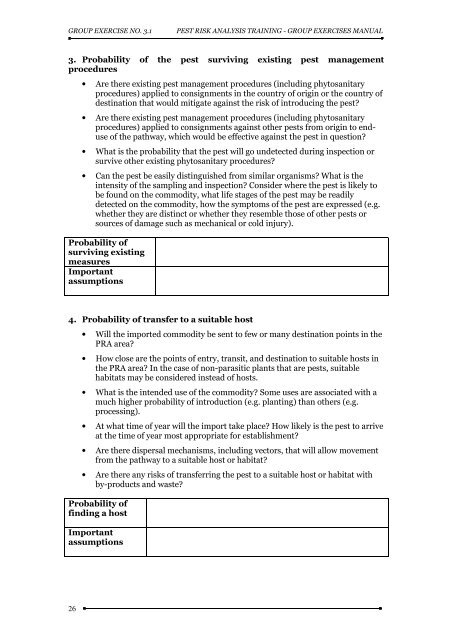PEST RISK ANALYSIS (PRA) TRAINING Group Exercises Manual
PEST RISK ANALYSIS (PRA) TRAINING Group Exercises Manual
PEST RISK ANALYSIS (PRA) TRAINING Group Exercises Manual
Create successful ePaper yourself
Turn your PDF publications into a flip-book with our unique Google optimized e-Paper software.
GROUP EXERCISE NO. 3.1<br />
<strong>PEST</strong> <strong>RISK</strong> <strong>ANALYSIS</strong> <strong>TRAINING</strong> - GROUP EXERCISES MANUAL<br />
3. Probability of the pest surviving existing pest management<br />
procedures<br />
• Are there existing pest management procedures (including phytosanitary<br />
procedures) applied to consignments in the country of origin or the country of<br />
destination that would mitigate against the risk of introducing the pest?<br />
• Are there existing pest management procedures (including phytosanitary<br />
procedures) applied to consignments against other pests from origin to enduse<br />
of the pathway, which would be effective against the pest in question?<br />
• What is the probability that the pest will go undetected during inspection or<br />
survive other existing phytosanitary procedures?<br />
• Can the pest be easily distinguished from similar organisms? What is the<br />
intensity of the sampling and inspection? Consider where the pest is likely to<br />
be found on the commodity, what life stages of the pest may be readily<br />
detected on the commodity, how the symptoms of the pest are expressed (e.g.<br />
whether they are distinct or whether they resemble those of other pests or<br />
sources of damage such as mechanical or cold injury).<br />
Probability of<br />
surviving existing<br />
measures<br />
Important<br />
assumptions<br />
4. Probability of transfer to a suitable host<br />
• Will the imported commodity be sent to few or many destination points in the<br />
<strong>PRA</strong> area?<br />
• How close are the points of entry, transit, and destination to suitable hosts in<br />
the <strong>PRA</strong> area? In the case of non-parasitic plants that are pests, suitable<br />
habitats may be considered instead of hosts.<br />
• What is the intended use of the commodity? Some uses are associated with a<br />
much higher probability of introduction (e.g. planting) than others (e.g.<br />
processing).<br />
• At what time of year will the import take place? How likely is the pest to arrive<br />
at the time of year most appropriate for establishment?<br />
• Are there dispersal mechanisms, including vectors, that will allow movement<br />
from the pathway to a suitable host or habitat?<br />
• Are there any risks of transferring the pest to a suitable host or habitat with<br />
by-products and waste?<br />
Probability of<br />
finding a host<br />
Important<br />
assumptions<br />
26













